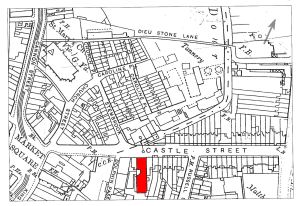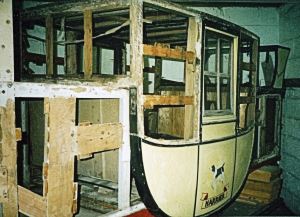It is hard to imagine that the building where the upmarket bridal shop, Country Brides, in Castle Street is, was once a major factory producing high quality coaches that were sent to the all corners of the globe. The factory was Hills that was founded in 1827 in premises in what was once Market Street.
Although the word ‘coach‘ today applies to various types of motorised people carriers, originally it was a horse drawn vehicle that had a fixed roof and some form of suspension. The word comes from the Hungarian kocsi and showing that coaches were Continental in origin. Indeed, many of the words used to describe the different parts of a coach, these days’ motorised vehicles, reflect this. The history of coaches or carriages, as they are also referred to, can be traced to at the least the days of the Roman Empire if not before. In the early days the suspension was usually made of leather but by the Middle Ages some vehicles had metal chain suspension and pivoting front axles. The chains made for a smoother ride than leather, as the carriage did not rest on the turning axles. The most common form of transport in those days, after horses, were four wheeled wagons.
Carriages with doors at the side and a step to help the passenger up evolved from these wagons and it is on record that the first fee-paying coaches were introduced in England, following the Restoration circa 1662. They set the style and were made of wood but did not have glazed windows at first. Instead, there was a leather roller type blind that the passenger could lower when it was dark or in inclement weather. The driver sat on a high seat at the front of the vehicle from where he controlled the horses and steered. Steering was controlled by the front wheels that had a centre-pivoting front axle that passed under the coachman’s box when the carriage turned the corner. As the driver was sitting above them, they were smaller than the rear wheels.
Over the next century, many improvements took place, including the introduction of glazed windows. However, it was not until 1816 that German coachbuilder, George Lenkensperger of Munich, developed the steering mechanism whereby the two front wheels turned about a centre that lies on the extended line of the back axle. Known as Ackermann steering after publisher Rudolph Ackermann (1764-1834) who acquired the English rights in 1818. This revolutionised coachbuilding for up until then the front wheels were smaller than the back wheels as the previous
Edward Hills, born in Chelmsford, came to Dover with his family about 1809 and they opened a coach-building firm in Market Street with offices in Biggin Street in 1827. Nine years later, in 1836, while the rest of Castle Street was in the process of being built, Edward moved into then number 47, now 54. This was for his own use and he also bought the property next door, number 48, now 56, for letting. He initially rented the second property out as a newsroom until auctioneer Charles Lamb, expressed an interest in it for his business. The Dover Proprietary Library, a private concern, rented the upper floors. The family lived on the upper floors of number 47 with the lower rooms and the back of both properties used for building coaches.
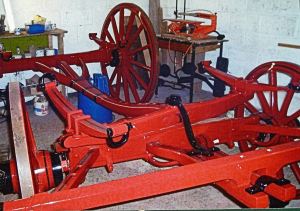
Ackerman Steering of coach during the process of being restored by Tony Newton. Courtesy of Tony Newton
At the time there were about 46,000 four wheeled carriages licensed in Britain and there were a number of other coachbuilders in Dover. Whereas they had kept to the traditional axles, Edward introduced the Ackermann steering. He also aimed his business at the wealthy that came to Dover for the ‘summer season’ in other words his firm made upmarket coaches for those who were prepared to pay. Edward married twice and was belonged to the Salem Baptist church. In 1839, he was appointed a Trustee of the new church erected in Biggin Street and laid the foundation stone. After which he was presented with the commemorative trowel.
The business was a success and Edward was active in the town’s affairs joining the Liberal Party and being appointed to the Board of Guardians who were responsible for sick and poor of the town. In 1855, he was involved in the preparations for a presentation of Dover’s French connections in the Maison Dieu – Stone Hall. He observed that to finish the presentation there was a need of a Royal Coat of Arms so his firm made one. This was presented to the town, which was gratefully accepted, by Alderman William Clarke and seconded by Cllr. John Birmingham who said the he ‘hoped that the wealthy of the Dover community would imitate the liberal example of Mr Hills, by contributions ot the restoration (of the Stone Hall), which be made the most handsomest in the county of Kent.’ The vote was unanimously agreed to. Edward and his employee were again congratulated and he was given a script of thanks, written on velum and sealed with the Corporation seal.
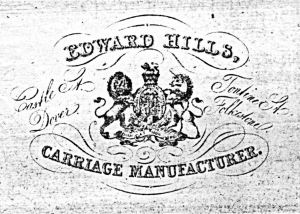
Edward Hills advert in the Dover & Folkestone Directory, Sinnock, Howard & Co 1875. Folkestone Library
Edward eventually retired and moved to Cambridge Villa, Whitfield where he died in 1885. By that time his two sons, Edward born 1841 and William born 1843 were running the business. His third son, Charles, had died through drowning in 1869. Edward junior and William initially ran the firm but later Edward bought his brother’s share and became sole owner. Edward had three sons, all destined to join the company and the eldest of which was Clement, born in 1869. Edward opened a smaller outlet in Folkestone but the Castle Street premises, except for the area used for domestic purposes and the part rented by the Library, was devoted to coach building. Hills coaches were prized not only by the local affluent market but the reputation had spread beyond the national to the international colonial market.
With the emphasis of personalisation, typical questions asked of the customer included the purpose for which the carriage was to be employed, the number and size of the horses that were to draw it and the type of terrain it was to be used. Armed with the information a full size working drawing was made, in chalk, on black canvass. Once the client gave their approval and the deposit paid the working drawing was used by six different groups of specialist craftsmen, within the factory, to build the coach.
In the area behind the Castle Street factory, separated from the main building by a yard, were the timber sheds. Ash, from Waldershare Park, was the main timber used along with imported timbers such as mahogany, walnut and birch. On arrival, the wood was sawn into planks of various thicknesses and then stored in the sheds for seven years to season! Each plank was about three-feet (1 metre) and was stacked with a space between the adjacent plank. They were all taken out every year to be brushed and restacked.
The carriage and body makers were on the first floor of the building and it was here that the seasoned ash was brought. It was then cut to make the frame, by the carriage-makers, using the work drawing. The body makers would then make the wooden beds of the under carriage along with shafts, pole and other wooden parts of the coach. When completed, the frame would go to the smith’s forge, which was in a separate building in the back yard.
There the strong side-plates were made, extending from the back to the front on both sides of the carriage to give rigidity. These were held in place by side bolts and screws and the craftsmen would also have to ensure that, when fitted, doors could open and close easily.
The carriage was then transferred to the paint room and the varnishing loft that were on the second floor of the building. The carriage would be painted with three coats of lead paint on which thin wet leather was placed over the roof, quarters and back and secured to the sides. The coach would then have been left to dry for fourteen days, by which time the leather was tight. Hills stored their varnishes for several years in order to gain a better gloss and more wear resisting power. It was said, their well-finished carriages were given twenty coats of paint and varnish! After the final varnish had hardened, it was rubbed down with pumice stone to ensure a smooth surface.
While this was going on, in the basement the timber wheels were made using elm for the centre, oak for the spokes and ash for the rim. On completion, they would be passed onto the forge and the iron tyres fitted. The iron was in a one-piece circle, heated to expand so that it could be placed in position round the wheel. The wheel was then dropped into a Hill’s patented water trough to ensure that shrinkage was even so that the iron tyre fitted tightly. The wheels were then fitted with axle boxes. The axles had tapered arms and were bought directly from a manufacturer. When completed the wheels would be painted and varnished in the same manner and matching the body of the coach.
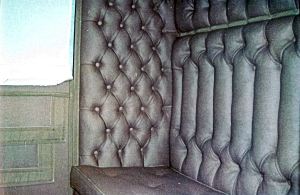
The restored coach upholstery undertaken by Nick Woods of Fairbourne Carriages. Courtesy of Tony Newton
In another department, on the first floor, but separate from the body makers by sliding doors, were the trimmers. They made the cushions using Hill’s ‘special cloth’ that, apparently, felt luxurious but was hard wearing and kept its colour and nap. The stuffing used was horsehair. Lamps, handles, straps and glazing were either made on the premises or bought in. The parts would then be moved to the downstairs show room where the coach was fully assembled and put on show.
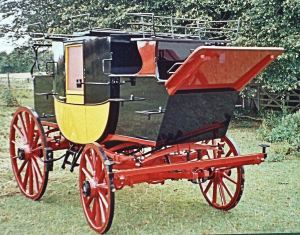
Mid 19th century top quality coach similar to those produced by Hills and restored by Tony Newton with the upholstery by Nick Woods of Fairbourne Carriages. Courtesy of Tony Newton
In 1887, the company sent several carriages, in charge of their foreman, to the Adelaide Jubilee Exhibition in Australia and succeeded in winning five of the highest orders of merit out of seven different categories for carriages. However, on 5 January 1888 the Castle Street works were destroyed by fire and the stables of Leney’s brewery, nearby, were completely gutted. The horses fortunately were led to safety. Some six thousand books many dealing with Kent and local history held by the Dover Proprietary Library, were lost. The adjacent Forster’s chemists – now Blakes – and the butchers next door were both badly damaged. An inquiry following the catastrophe showed that the pressure of the town’s water supply was inefficient at the time.
After the fire, the library moved permanently to Granville Gardens and with the emphasis on fire prevention, the coachworks were rebuilt. The walls were strong and substantial and all the fireplaces were fitted with thick iron shutters that were let down when the rooms were to be left empty. The joists were nine-inches by four-inches and the floors two inches-thick, with iron tongues between each board. In order to isolate the ground floor showroom and offices from the main factory, iron girders, coke-breeze, cement and ‘strong’ asphalt’ was used along with iron doors. The building was also fitted with a patent lift worked by one man.
Even though the disaster reduced the company output, that year Clement Hills, along with the foreman A Bucknor, managed to show eight carriages at the Melbourne, Australia, Centennial Exhibition. They then toured the principal business centres of Australia and on the way back to England visited agents in cities in India. They brought back with them ‘a good sheaf of orders to supplement home trade.‘ Although this was still the hey-day of the horse drawn carriages with some 500,000 coaches in use, their days were coming to an end. The last fee-paying coach ran between Dover and Deal in 1882 – the year after the opening of the Dover-Deal railway line.
The first motor car made its appearance in Dover in December 1896 and was said to have created considerable noise in its workings and left behind it ‘the rather unpleasant smell of burnt petroleum!‘ Nonetheless, the demand for horse drawn coaches fell and for awhile Hills became the specialised coach painters of Daimler bodies made by Palmer & Son of London Road. However, the factory closed in 1906 by which time Cresswell and Newman – Architects and Civil Engineers – occupied the upper floors of the Castle Street factory. Edward and his wife Alice had lived upabove the factory for a number of years and then moved to ‘Shortlands’ Park Avenue and finally to Cambridge House (previously Villa), Whitfield, where he died aged 87, on 25 January 1928.
Alfred Leney and Co, who owned the nearby Phoenix brewery, bought the factory and let it to Dover Motor Co Ltd motor engineers. They changed their name to Dover Autocar Co. and was run by Harry Hooper, Francis Sheridan and Jack Tyson. The company also had premises in Effingham Crescent and a taxi business. Rogers and Stevens, auctioneers, superseded Cresswell and Newman in occupying the upper floors.
Following World War II (1939-1945), Horace Sawyer’s firm initially occupied the old factory until Folkestone Motor Company acquired the building and applied for a licence to redevelop it – a requirement in the early post-war years. This was approved in April 1951 and the programme went ahead at the estimated cost of £12,000. The following year, their subsidiary, Kennex Coachworks Ltd, manufacturers of motor vehicle bodies, moved into the lower floors and the County Court administrative office rented the upper floor.
In the early hours of 27 June 1955, fire broke out and although the 19th century fire precautions stopped the fire spreading and reduced the potential damage internally, the destruction was still extensive. Repairs were undertaken but the company decided to have a rethink and in the summer of 1958, Kennex moved into a new factory in Barwick Road on the Poulton Industrial estate. This enabled them to double output of commercial conversions but in 1962, the company was bought out.
The once upmarket carriage factory was taken over by Henleys’ motorcar accessories and then Unipart – keeping up the vehicle tradition. At the time of writing the former industrial premises has been totally revamped and the ground floor is occupied by an upmarket gown and wedding shop, again in keeping with tradition.
The photographs used to illustrate the building of a typical Hill’s coach were provided by Tony Newton and taken while he was restoring a similar coach. The upholstery was undertaken by Nick Woods of Fairbourne Carriages. The photograph on the right is of both gentleman during a discussion.
Prepared: 23 April 2014

